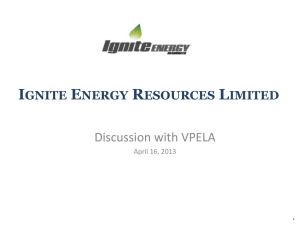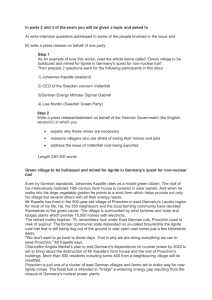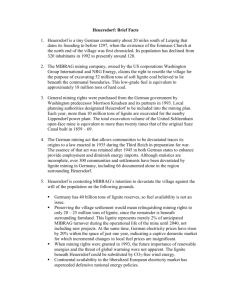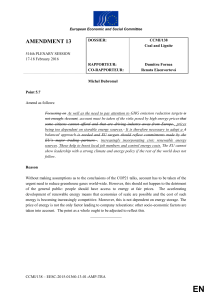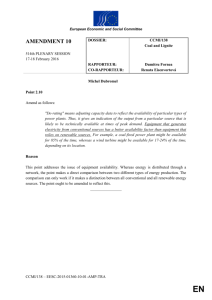The Bitter Inheritance of “Real Socialism”
advertisement
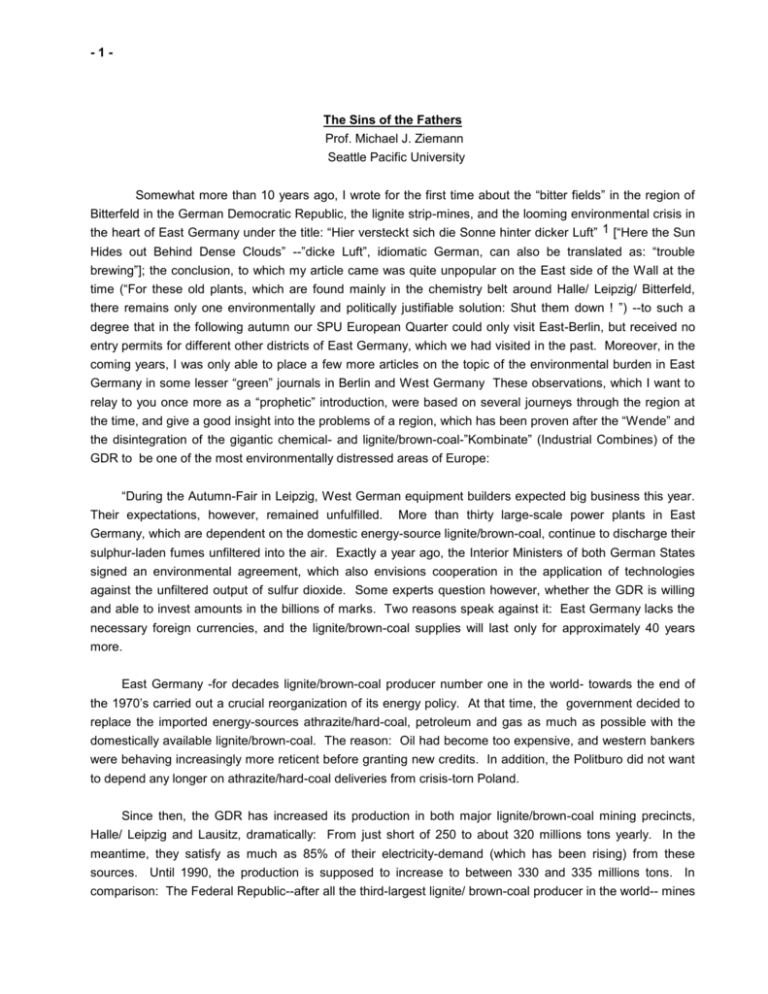
-1- The Sins of the Fathers Prof. Michael J. Ziemann Seattle Pacific University Somewhat more than 10 years ago, I wrote for the first time about the “bitter fields” in the region of Bitterfeld in the German Democratic Republic, the lignite strip-mines, and the looming environmental crisis in the heart of East Germany under the title: “Hier versteckt sich die Sonne hinter dicker Luft” 1 [“Here the Sun Hides out Behind Dense Clouds” --”dicke Luft”, idiomatic German, can also be translated as: “trouble brewing”]; the conclusion, to which my article came was quite unpopular on the East side of the Wall at the time (“For these old plants, which are found mainly in the chemistry belt around Halle/ Leipzig/ Bitterfeld, there remains only one environmentally and politically justifiable solution: Shut them down ! ”) --to such a degree that in the following autumn our SPU European Quarter could only visit East-Berlin, but received no entry permits for different other districts of East Germany, which we had visited in the past. Moreover, in the coming years, I was only able to place a few more articles on the topic of the environmental burden in East Germany in some lesser “green” journals in Berlin and West Germany These observations, which I want to relay to you once more as a “prophetic” introduction, were based on several journeys through the region at the time, and give a good insight into the problems of a region, which has been proven after the “Wende” and the disintegration of the gigantic chemical- and lignite/brown-coal-”Kombinate” (Industrial Combines) of the GDR to be one of the most environmentally distressed areas of Europe: “During the Autumn-Fair in Leipzig, West German equipment builders expected big business this year. Their expectations, however, remained unfulfilled. More than thirty large-scale power plants in East Germany, which are dependent on the domestic energy-source lignite/brown-coal, continue to discharge their sulphur-laden fumes unfiltered into the air. Exactly a year ago, the Interior Ministers of both German States signed an environmental agreement, which also envisions cooperation in the application of technologies against the unfiltered output of sulfur dioxide. Some experts question however, whether the GDR is willing and able to invest amounts in the billions of marks. Two reasons speak against it: East Germany lacks the necessary foreign currencies, and the lignite/brown-coal supplies will last only for approximately 40 years more. East Germany -for decades lignite/brown-coal producer number one in the world- towards the end of the 1970’s carried out a crucial reorganization of its energy policy. At that time, the government decided to replace the imported energy-sources athrazite/hard-coal, petroleum and gas as much as possible with the domestically available lignite/brown-coal. The reason: Oil had become too expensive, and western bankers were behaving increasingly more reticent before granting new credits. In addition, the Politburo did not want to depend any longer on athrazite/hard-coal deliveries from crisis-torn Poland. Since then, the GDR has increased its production in both major lignite/brown-coal mining precincts, Halle/ Leipzig and Lausitz, dramatically: From just short of 250 to about 320 millions tons yearly. In the meantime, they satisfy as much as 85% of their electricity-demand (which has been rising) from these sources. Until 1990, the production is supposed to increase to between 330 and 335 millions tons. In comparison: The Federal Republic--after all the third-largest lignite/ brown-coal producer in the world-- mines -2- at present about 110 millions tons annually. For the environment, the renaissance of lignite/brown-coal has had disastrous consequences. If everything works out according to plan, in the mining-region of Cottbus alone five new strip-mines will be developed by 1990. Even today, a surface area goes as big as 20 soccer fields is lost daily. The excavators of the ‘Kombinate’ (‘Industrial Combines’) Senftenberg’ and Bitterfeld scar the countryside, drive people from their homes, wherever they stand in the way: Neither villages nor settlements can stop the excavators, they must yield. Years, often decades, pass until the rock- and gravel-deserts resemble fields, forests and lakes again. And even if the landscape-architects will plan the reconstruction ever so carefully --it remains a countryside from the drawing board. The “ black snow “--dust and grime from the more than 250 millions tons of soft coal burned yearly-- is everywhere. It covers the roads, sidewalks and cars in greasy layers, makes breathing difficult for the people and, even on beautiful days, lets it appear sometimes as if the sun is shining through a cellophane curtain. To keep the strip-mines dry, the pumps run day and night throughout the region. As a result of the dropping of the groundwater-table, so many wells have dried up that tank-trucks have had to take over provisioning households in the area with a supply of fresh, clean water. The worst, however, is the enormous burden of sulfur dioxide (SO2) discharged into the air, which descends again as acid rain. Even according to official statements, 40% of the forests in East Germany are virtually beyond saving. If there were a competition for the title “Major Filth-Ejectors of Europe ”, the East German power stations burning lignite/ brown-coal dust would easily take the top honors. In addition, there are numerous briquette-factories, smaller industrial-power stations and coalprocessing plants: cokeries, gasification- and hydrification-plants. A number of these often completely outdated factories were originally slated to be retired. not least of all because of the environmental hazards. But then came the revival of lignite/brown-coal as domestic energy source and plants ripe for the scrap-metal heap suddenly came to be seen as indispensable: Furnaces and boilers left from the Twenties and Thirties, which had already been shut down 20 years ago, received makeshift overhauls and were put back into operation; retired steam-locomotives were reconverted from oil burners to grate firing and installed as stationary steam-donors, and industrial furnaces and heating plants switched from of oil to lignite/brown-coal. Small wonder that the GDR has become world-wide the nation with the highest fly ash and pollutant burden of the air. This dubious honor is shared (and felt) by East Germany’s immediate neighbors. Pollutants do not recognize any borders, and thus East Germany has become the top exporter of sulfur-dioxide: an estimated 300 000 tons yearly to Poland, 122 000 tons to the Federal Republic of Germany, 120 000 tons to Czechoslovakia. A retooling of East German power stations with desulfurazation equipment could solve the problem. In the Federal Republic of Germany (West Germany), all power stations with an output of more than 300 Megawatts have to be desulfurized by the first July of this year. Excluded are old plants, which are to be shut down, however, at the latest by 1993. The yearly SO2 output has already been reduced by about two thirds to circa 500 000 tons. This nation-wide desulfurazation-program will cost the utility companies and, ultimately, the electrical power customers about fifteen billion (West) German marks. -3- Already, there has been considerable speculation on this side of the Wall, whether East Germany will purchase West German desulfurazation equipment or not. But for such a financial tour-de-force, the GDR especially lacks the liquid assets; the total costs are estimated to amount more than ten billion (West) German marks. Moreover, only the desulfurazation of the newer power stations is meaningful anyway. For the old plants, which are found mainly in the chemistry belt around Halle/ Leipzig, there remains only one environmentally and politically justifiable solution: Shut them down ! Besides, the rain already rises sour in the throats of the responsible East German politicians as well. They know only too well that the “ healthy-liming of the forests “, the “ planting of smoke-hardy groves “, or the construction of very tall chimneys, which only dilute the muck and distribute the particles over a wider area, is not enough. Attainment of the Socialist Planning Goals, however, always take precedent- at least for the time being- over everything else. If the Plan demands the increase of production and, as a result, existing environmental-protection-equipment has to be be overburdened, the fulfillment of the Plan usually takes priority. On the other hand, the domestic “Dresden Method” [‘Dresdner Verfahren’] for the smoke-gas filtration of smaller or average boiler installations has progressed to production-readiness as a result of three years of testing. The technology was developed by Prof. Günter Heinrich of the Department of “Energy Conversion” [‘Energie-Umwandlung’] of the Technical University, Dresden, in cooperation with the pertinent industries. The smoke emerging as a result of firing boilers with lignite is no longer emitted directly into the air, but scrubbed in vortex particle precipitators [in ‘Wirbelschichtabscheidern’] with lime-water. The lime-water, mixing in the vortex precipitator with the smoke emissions, picks up up to 98 percent of the dirty particulate matter and approximately 80 percent of the sulfur dioxide; the lime in the water binds particulates and sulfurdioxide to itself and becomes dirty plaster -in the experimental heating plant of the LPG (“Agricultural Production Cooperative”) Cunnersdorf, in the district of Dresden-Großenhain, for example, 11.8 tons of dust and 18.9 tons of sulfur-dioxide in a year (heating plants of agricultural production cooperatives in East Germany are typically fired with unprocessed, uncleaned lignite dust ). The chimney here emits virtually only water-vapor. The scrub-water, warmed up by the smoke emissions, can be used for heating purposes. As already mentioned, the intensified lignite/brown-coal mining in the precincts Halle and Leipzig also impairs the drinking water supply for the local population. Even if all existing water- resources in the region are exploited [please, note: the extent of the aquifer Wolfen/ Bitterfeld was still unrecognized during the East German era], “the drinking water needs of the population can not be assured”, professed a representative of the “Water-Resources-Management Board” Saale-Werra. Therefore “it is requisite to supply the region with additional quantities of water of uniform quality from the Thuringian area by long-distance-pipeline.” According to statements by fresh-water experts, construction of a reservoir and dam have begun meanwhile in the mountain range above the village of Unterweißbach on the river Lichte, in the county of Neuhaus on the Rennsteigweg. After completion, the reservoir dam-wall will reach a height of 100 meters and the reservoir itself will have a capacity of approximately 44 million cubic meters of fresh water. The first barrier dam, 20 meters high, with a current capacity of 3.2 millions cubic meters, has been almost completed. 2 Now Bitterfeld holds a new record. The city and the rural district, which have become the quintessence of unscrupulous devastation of the environment, are in the meantime considered to be the best investigated -4- region in Germany and presumably far beyond it. Approximately thirty million marks have been spent by the Federal Republic of Germany and the State of Saxony-Anhalt since the German reunification simply to investigate the frightening wounds of more than hundred-fifty years of mining and chemical-industry, which have reached unimaginable dimensions during four decades of socialist exploitation of men and nature . Because it is here in Bitterfeld and Wolfen that the extreme stress on the environment through the poisonous backlog of the chemical industry combines in a singular and often unfortunate manner with far-reaching disturbances of the countryside and the water table caused by lignite/brow-coal strip-mining. In the meantime, the picture has become more complex. Medical researchers, for example, could report comforting findings at the ‘Second Bitterfeld Environmental Conference": Their investigations did not uncover any evidence of lasting health-damages. By comparison with individuals living in the industrial areas of West Germany, tissue samples taken from a cross-section of the population of the Bitterfeld-Wolfen region exhibit hardly any greater contamination through heavy metals or long-lived chlor-organic substances; in the case of some substances tested for, the values determined in Bitterfeld lie even lower. Acute health-risks have been removed in the meantime as well. To assure that contaminants do not reach the human food- chain, however, livestock is no longer permitted to graze on the severely polluted meadows in the flood-plain of the basin. Game, which is killed there, always has to be examined and often has to be discarded, because its inner organs (lungs, liver, spleen, pancreas) show an excess in chlor-organic substances. Nevertheless, there is no lack of game in the region. Günter Eckstein, commissioner of the “Department of Environmental Protection” for the district, speaks with pleasure of the “Bitterfeld Paradox”, when he describes the immediate coexistence of extreme chemical burden and diverse habitat. In the area of the “Spittelwasser” for example, through which the effluent of the chemical factories was once being diverted untreated into the small river Mulde, beavers have settled again. The Mulde-Reservoir displays a prodigious wealth of fish, and the number of the storks returning to the flood plains of the Mulde grows from year to year. As in other regions, which were forced by the Socialist planning economy to suffer quietly the disastrous consequences of the ruthless treatment of natural resource in East Germany, people here attempt to shake off the reputation as an ecological disaster-area --a reputation, which after the fading away of the first commiserating interest has proven to be rather disparaging. Rather, the district wants to present itself, or at least some of its projects, as examples for successful reconstruction before the coming of the World’s Fair to Central Germany in the year 2000, . Many a step has already been taken. The previously gloomy gray of towns and places is interrupted over and over again by fresh color. Parts of the worn-out chemical plants have been torn down in the meantime, and some new businesses have established themselves on the old industrial terrain itself. Here, according to the projects of the planners, the Chemical/Industrial Park Bitterfeld-Wolfen ought to come about. Approximately 200 businesses there already offer work-places for more than 7 000 employees. Admittedly, up to now these are mostly service companies, the manufacturing trade is only sparsely represented -a circumstance, which concern district council president Tischer and Bitterfeld’s mayor Pchalek. Especially, since unemployment in the region has already risen to more than 20% since the shutdown of the chemical industry and the decline of the lignite-mining. Unemployment rates are expected to climb further, when many contracts of the so-called secondary labor-market (job-corps and part-time schemes sponsored by the federal government) run out this summer. The region’s wrecking- and removal-work will end in the -5- foreseeable future, but publicly financed technical reconstruction- and rehabilitation projects will have to continue. The worst inherited burdens of the abused region can only be solved with the help of the most ultramodern technologies. According to the experts, the biggest nightmares are not inflicted by the visible horrors--not even by the specter of the mine “Johannes”, which has attained sad fame as the “Silver Lake”. Rather, these toxic effluents of the film-factory Wolfen, which were pumped into this former strip-mine since the Twenties, have proven to be relatively safely embedded in a kind of gel-tub formed by the remnants of the cellulose production, which were also diverted into the mine. Based on our present state of knowledge, it has been calculated that we can be reasonably sure that these substances will not infiltrate the water table nor spread with the ground water; thus the original reconstruction/ rehabilitation plans here have been postponed. The most difficult questions meanwhile remain unsolved; all the worst damages are in reality invisible. Below the former lignite strip-mine “Antoine” for example, which strikes the incidental observer as rather harmless and almost like a successful wetland-”Biotope”, the ground-water levels are contaminated to a depth of 60 meters (195 feet) with chlor-organic solvents... Data have now become public, showing that during the last 30 years this mine became the depository for about 70 000 tons of Hexachlorcyclohexan, a substance related to the nerve toxin “Lindan”. Two other mine sites, which had also served as dumping ground for a variety of highly toxic remnants, already have intensive contact with the ground-water table. During the analyses of rock formations, soil stratification, and groundwater-levels, researchers drilled into a highly contaminated, previously known aquifer extending below both chemical combines (Kombinate) Bitterfeld and Wolfen. The cavern is estimated to contain upwards of 200 Million cubic meters. Currently, a part of the contaminated water is drawn off before it can leave the area --approximately 10 000 cubic meters per day. About two thirds of the effluent are diverted to a newly erected treatment plant; however, a third is so badly polluted that even this specially designed treatment plant is unable to handle it, and must be treated in a different manner. Present price tag: about 40 000 German marks day in day out, approximately 15 million German marks every year. The crucial question here once again: who ought to bear these continuously increasing costs? And further still: Who is able to and who should be responsible for the clean-up cost of the entire ground water reserves below Bitterfeld and Wolfen? The costly pumping operations are no paneceia, one basically just maintains present levels and attempts to forestall acute danger to the life and health of the citizens. Such questions arise about many of the inherited (pollution) burdens from the former GDR. Often the perpetrators (giant state run enterprises) are well known, but can no longer be prosecuted, since they have been dissolved and are no longer legal entities. In their place the Federal or State governments jump in (and here only the “Bundesrepublik Deutschland”, since the state of Saxony-Anhalt did not exist before 1990 -the GDR was divided into political districts [“Bezirke”]). In order to attract any new businesses to locate on the old industrial sites, they are absolved of responsibility for the elimination of already existing debris, pollutants and effluents. Germany established in 1990 the “Federal Institute for Unification Specific Tasks”, given the charge to finance such projects. The “BvS” feels responsible, however, only if there exists “acute danger to assets worth protecting (“...wenn akute Gefahr für schützenswerte Güter besteht.”)! To take preventative -6- measures or make prepare for future eventualities (still) does not fall under their responsibilities. As a result, there continue to be heated disputes over the question whether the ground-water supply in itself should be protected, or whether it becomes a “protectable asset” only if it is intended to be utilized as drinking water. Some the 23 exemplary mammoth projects of rehabilitation and reconstruction in the new states, for which the federal government of Germany is committed to bear two-thirds of the financial burden, have found progress to be slow and tedious for some of these reason. In Bitterfeld the impatience of the public grows in the meantime. To be sure, the head of the “Department for Environmental Protection”, Dr. Eckstein, shows some understanding for the fact that public moneys can only be spent after detailed examination, but in BitterfeId time is precious. Especially, since the polluted water will not remain, where it was so long: since --after the termination of the surface mining activities alluded to above-- the overall water-table of the region begins to change. With the end of the pumping to drain the mines, invariably, inexorably the artificially low ground-water-table begins to rise again, wherever the pumps are shut off. These pumps now prevent, for example, that highly contaminated water flows into the nearby surface-mining operation “Goitsche”. With rising water levels, the contaminated water will begin to seep into the cellars of houses, and in several instances has done so already. Because of the insufferable stench of the polluted muck in their cellar, a school had to be closed for some time. It has become exceedingly clear that even concrete can not resist the high acidity of this water. Furthermore, there is cause to fear that the contaminated ground-water itself will begin to extend its reservoir towards the northeast, as water-levels rise. In the meantime, using specially developed models, the responsible scientists and politicians attempt to forecast such developments as accurately as humanly possible, in order to be able to initiate suitable counter-measures in a timely fashion. These theoretical considerations of a constantly changing and increasing problem are, admittedly, regarded by many community activists and even many ordinary citizens with the suspicion, that these new measurements and models are designed only to delay the necessary (but vastly expensive) measures. They argue that the sources of the threat are adequately known, thus the contamination ought to be contained, before it spreads further. Scientists and technicians have floated several schemes. If any of these would actually prove useful for problems of the magnitude and scale of Bitterfeld’s ecological disaster, nobody can say with certainty. Moreover, a comprehensive overall concept for this unprecedented case is still missing, since consensus still avoids those in positions of scientific and political responsibility. Bitterfeld - Wolfen and the district surrounding the “chemical / industrial park” will remain a challenge for a very long time. 3 _______________________ Notes 1 “Die Sonne versteckt sich hinter dicker Luft”, in Deutschland, November - Dezember 1987, Societäts-Verlag, Frankfurt am Main. 2 Illustrationen und Statistiken(Ost) aus: Die DDR im Überblick, PANORAMA DDR, AuslandsPresseargentur GmbH, Berlin-Mitte, März 1987. Statistiken (West) aus: DDR-Handbuch, 4. überarbeitete und erweiterte Ausgabe, Verlag -7- Wissenschaft und Politik, Köln, !988. 3 “Zweite Bitterfelder Umweltkonferenz”, Kulturchronik, Nr. 2, 1995, Verlag Bild und Kunst, Bonn 1996

